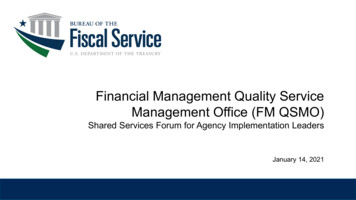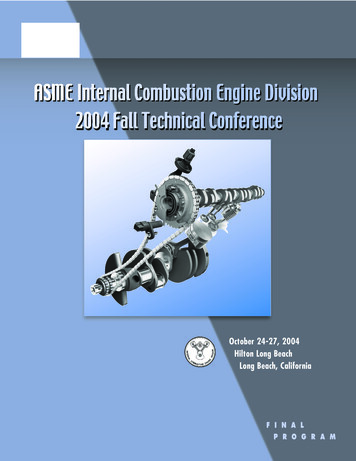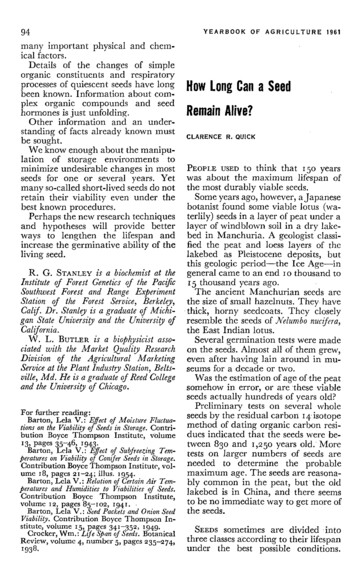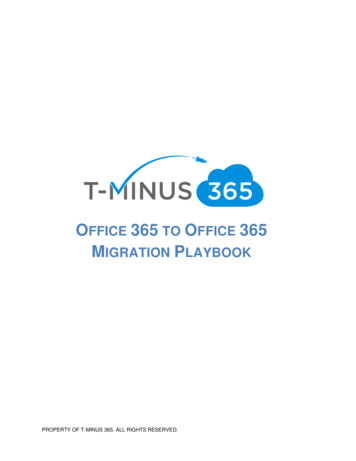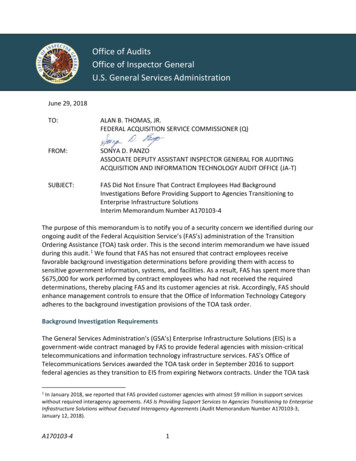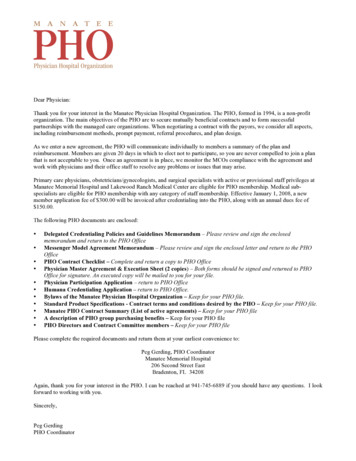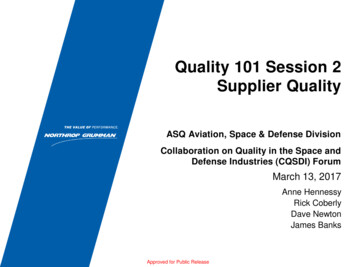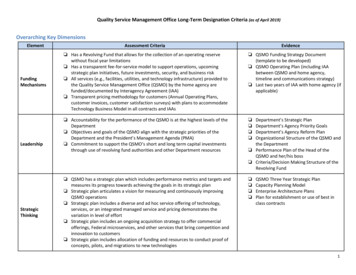
Transcription
Quality Service Management Office Long-Term Designation Criteria (as of April 2019)Overarching Key gicThinkingAssessment CriteriaEvidence Has a Revolving Fund that allows for the collection of an operating reservewithout fiscal year limitations Has a transparent fee-for-service model to support operations, upcomingstrategic plan initiatives, future investments, security, and business risk All services (e.g., facilities, utilities, and technology infrastructure) provided tothe Quality Service Management Office (QSMO) by the home agency arefunded/documented by Interagency Agreement (IAA) Transparent pricing methodology for customers (Annual Operating Plans,customer invoices, customer satisfaction surveys) with plans to accommodateTechnology Business Model in all contracts and IAAs QSMO Funding Strategy Document(template to be developed) QSMO Operating Plan (including IAAbetween QSMO and home agency,timeline and communications strategy) Last two years of IAA with home agency (ifapplicable) Accountability for the performance of the QSMO is at the highest levels of theDepartment Objectives and goals of the QSMO align with the strategic priorities of theDepartment and the President’s Management Agenda (PMA) Commitment to support the QSMO’s short and long term capital investmentsthrough use of revolving fund authorities and other Department resources QSMO has a strategic plan which includes performance metrics and targets andmeasures its progress towards achieving the goals in its strategic plan Strategic plan articulates a vision for measuring and continuously improvingQSMO operations Strategic plan includes a diverse and ad hoc service offering of technology,services, or an integrated managed service and pricing demonstrates thevariation in level of effort Strategic plan includes an ongoing acquisition strategy to offer commercialofferings, Federal microservices, and other services that bring competition andinnovation to customers Strategic plan includes allocation of funding and resources to conduct proof ofconcepts, pilots, and migrations to new technologies Department’s Strategic PlanDepartment’s Agency Priority GoalsDepartment’s Agency Reform PlanOrganizational Structure of the QSMO andthe Department Performance Plan of the Head of theQSMO and her/his boss Criteria/Decision Making Structure of theRevolving FundQSMO Three Year Strategic PlanCapacity Planning ModelEnterprise Architecture PlansPlan for establishment or use of best inclass contracts1
Quality Service Management Office Long-Term Designation Criteria (as of April 2019) QSMO articulates a “partnership” strategy for workforce and assets in 2-3-5 yearincrements as a part of its Strategic Plan, taking into consideration legacyproviders and contractors/assets QSMO has a capacity model in place that allows it to scale up or down based ondemand QSMO measures its own progress towards achieving goals in its strategic plan Customers have a voice in the strategic plan process before it is finalized Strategic plan aligns with PMA, Cross-Agency Priority Goals, and overall Federalstrategic direction for sharing quality services in the QSMO area2
Quality Service Management Office Long-Term Designation Criteria (as of April 2019)Key Dimension #1: Financial - Funding sources and service costing/pricing methodologiesElement CapitalInvestment Plan Accounting,Auditing andFinancialReporting of theQSMO Assessment CriteriaCapital investment plan exists and clearly maps to strategic plan. Capital needsare documented in Major IT Business Case or Agency IT Portfolio Summarydocumentation along with appropriate sources of fundsIf IT assets are necessary for services delivered, investments include plans tobuy commercial technology as Software as a Service, as determined by marketresearchIf IT assets need to be built or maintained by government (microservices),investment plans include funding to do so that minimizes spikes in customerfeesDocumentation/process exists to show that investments have been used asplanned and how the Task Order Review Board is being used to maintainalignment where applicableControls exist for Anti-Deficiency Act violations, funds independent auditingplanDemonstrates effective management and timely closure of corrective actionsarising from QSMO audit findings and recommendationMaintains no material weaknesses in their internal controls or systemconfigurations that contribute to customer audit deficienciesEvidence QSMO 5-year investment plan and relatedCPIC reporting documentation SSAE-18Budget Execution/Funds Control PolicyCost ModelAllocation ModelCurrent Plan of Action and MilestonesListing (POA&M) List of material weaknesses (if applicable)and latest audit or GAO report, includingcustomer findings directly related to theQSMO3
Quality Service Management Office Long-Term Designation Criteria (as of April 2019)Key Dimension #2: Organization - Governance, stakeholder engagement, organizational capacity, strategy, and personnel skill sets/experienceElement Staffing CustomerEngagementGovernance ging serviceofferings,upgrading Assessment CriteriaStaffing and contract support strategies are aligned with current/future needsof QSMO, support flexibility to meet future demands, and allow for seamlesstransition of new options selected by agenciesEnsures needed skill sets are readily available to meet current andanticipated/expected customer loadDistinct integration/implementation teams exist if solutions offered necessitateITCustomer relationship management strategy allowing for QSMO to interactwith customers either face-to-face or virtually on a recurring basisHas established a dedicated Project Management Office (PMO)Project leadership team with appropriate areas of expertise and relevantexperience is identified and in placeFormal project teams with subject matter skills are aligned to transitioningbusiness functions (sending and receiving)Staff and/or contract support, with appropriate certifications (e.g., PMP)commensurate with current and anticipated needs. Performance metrics forstaff and contractors are linked to strategic goals of the QSMOPost-transition commitments/support for dedicated team members next roleRetention incentives or transition metrics achievement incentivesCustomer engagement and implementation processes use the M3 PlaybookCustomer Service Operations clearly documented and staff trainedDefined incident notification and escalation protocols process exists whichincludes target response times for resolution as well as assigned executive levelcustomer relationship managers for major customers Customers are provided the opportunity to formally review and provide inputon strategic decisions and decisions that impact daily operations Release management process that deliberately engages customer in releasepreparedness and communications Process exists to assess the impact of adding new customers and impacts arecommunicated to governance board, parent agency and existing customers QSMO adheres to the Federal Integrated Business Framework (FIBF) and anorderly and disciplined approach to managing, controlling, and documentingproposed or actual system and/or operational changes to the FIBF exists in EvidenceDocumented HR strategy to maximize thevalue of a blended workforce (incl. use ofcontractors, FTE, temporary hires, etc.)Support Team Organizational Models chartsand geographic distribution of staffList of workforce certificationsSample Performance PlansTransition Team Retention Plan Review escalation processesCustomer Services Ramp/Capacity ModelCustomer On-Boarding ModelOn-Boarding Capacity estimation model Customer Satisfaction Survey Results Governance and Change ControlManagement Documentation One year of meeting minutes fromCustomer Advisory Boards Customer communications and messages FIBF Adoption Plan TORB Plan and future Charter/SOP4
Quality Service Management Office Long-Term Designation Criteria (as of April 2019)technology) accordance with the roles, responsibilities and processes of the Task OrderReview BoardChange control board includes customer representativesInclusion of Cyber Security considerations in the change control processCommunication of service changes (and impact on pricing) is forward lookingand intentionalOngoing coordination with other QSMOs and policy organizations to ensurecontinued alignment and interoperability with standards, etc.Where Standards Leads and QSMOs are housed in the same agency (e.g.,Treasury), clear demarcations should exist that enforce separation butencourage alignment and interoperability (see previous bullet)5
Quality Service Management Office Long-Term Designation Criteria (as of April 2019)Key Dimension #3: Operations - Transition, operations, support services, maintenance and recoveryElement SLAManagement Service DeskSupport COOP/BusinessContinuity Plan Quality/ProcessManagement RecordsManagement/DiscoveryDataManagement Assessment CriteriaService Level Agreement (SLA) metrics are developed and reviewed annuallyand adjusted in concert with SLA changes and pricingSLA metric results are tracked at an individual customer basis and areavailable and shared with customers at least monthlyAlignment with QSMO standard Key Performance Indicators (KPIs)QSMO uses a per incident, transactional surveying mechanism to allow foranonymous scoring by users of service desk resolutionsService desk resolutions are meaningful and useful to usersQSMO has implemented service desk system enabling customers totransparently assess current state of requests, comportment to relevant SLA,escalation/contact information, and periodic reportingContinuity of Operations (COOP) systems failover capabilities include abilityto meet Recovery Time Objectives (RTO) and Recovery Point Objectives (RPO)based on documented customer agreements and at least annual testing offailover to alternative solutionsAnnual COOP testing that includes coordination with customersA COOP score as determined through Continuity Evaluation Tool by the FEMANational Continuity Program (NCP). It is recognized that the QSMO’s COOPscore may be rolled up into the Parent Agency’s score at this time due tocurrent policy. As applicable, QSMO should indicate if it has another way ofdocumenting its COOP activitiesQSMO holds an industry accepted certification in quality or processmanagement (e.g., ISO 9001/Baldridge or CMMI)Transactions are audited for quality on a regular basis by an independententity (performance quality assessment model)Has a records management strategy and implemented solution that comportsto records schedule of customersCompliant with records management laws and regulations, clear road map,tracking, and execution for compliance of permanent agency records by 2019in accordance with M-12-18Compliance with OMB requirements such as M-13-3 and A-130 onappropriate data management throughout the information life cycle andmanagement of information as an assetEvidence Review SLAs and pricing in either existingIAAs or proposed drafts Individual SLA reporting on a monthly basis Delivery of KPI results Service desk support documentation thatdemonstrates incident based surveying,customer satisfaction, and transparency ofend user into service request status Documentation of COOP activities (or aCOOP score by FEMA) that addresses 13elements Documentation of active certification Documentation, including procedures, forrecords management capability Policy, guidelines, templates for dataquality, data strategy, and platformsolutions that aid in establishing data6
Quality Service Management Office Long-Term Designation Criteria (as of April 2019) Compliance with relevant statutory and policy requirements Enables customer data to be segmented appropriately for the purposes ofauditing, discovery, and litigation activity Data is used as an asset within the QSMO and similarly available to customersin a manner that increases mission return on investment by becoming moreefficient with data management and analysismanagement maturity Strategy that establishes a vision for thestrategic use of data including use of dataand information as an asset in drivingdecision making7
Quality Service Management Office Long-Term Designation Criteria (as of April 2019)Key Dimension #4: Program Management - Compliance with government laws/regulations/policies/guidance and effective program/projectmanagement when undertaking improvement projects, major upgrades and/or new customer implementationsElement Mature ProjectManagementProcesses(for migrationsandmodernizations) PerformanceManagement ImplementationGuidance ProgramManagement (allphases of M3) 1Assessment CriteriaFollows a generally recognized project management approach (e.g., PMBOK,ITIL)QSMO risk management processes consistent with best practices1QSMO cost management practices consistent with best practicesQSMO schedule management practices consistent with best practices for M3for integration (documenting results of control gates)Compliance with SLAs for operational performanceVariances to Cost, Schedule, and Performance kept within acceptable tolerancesas defined in the Program Management PlanFull life-cycle inclusion of cybersecurity requirements in program managementprocessesDesignated responsible and accountable individual(s) are identified forperformance accountabilityPerformance metrics shows consistent improvement or continuous high level ofperformance in QSMO Performance Assessment resultsInspection/oversight processes definedHas documented customer engagement process that follows M3Works with customer to integrate project management processesEngages with a working group/stakeholder committee (role/responsibilities,membership, governance)Assesses readiness of Business Unit/Area/Team to transition to new systemsImplement cross-discipline decision and issue management forumConsistently Documents Risks, Action Items, Issues and DecisionsConsistently follows the Risk Management PlanMonitors the program costs and allocationsConsistently manages the Integrated Master Schedule (IMS) and analyzesimpact to downstream activitiesTest Results documented against requirements and validated for accuracy andcompleteness EvidenceProgram Management Plan, includingalignment to M3 (includes NIST RiskManagement Framework 800-37)Risk Management PlanSchedule Management PlanCommunication Management Plan Strategic Plan performance goals and results Performance quality assessment model andimpact approach Customer engagement strategy Readiness Assessment results Project Reporting Processes (dashboards,etc.) Risks, Actions, Issues, Decisions LogAs identified in the “Project Management Body of Knowledge” (PMBOK) guide.8
Quality Service Management Office Long-Term Designation Criteria (as of April 2019)Key Dimension #5: Technology - System tools and processes, facilities and securityElementFull Life CycleTechnologyManagement &ModernizationSoftware/SystemAlignment toRequirementsPrivacy Policy,ProceduresAuthority toOperateData Centerand/or CloudOperationsAssessment Criteria QSMO has strategy to offer cloud-based technical solution alternatives and hasan agile and expedient method for driving competition at the task order level QSMO has a strategy for migrating current customers to the cloud-basedtechnical solutions QSMO strategy incorporates a plan for data migration and integration thatleverages innovative and modern exchange technologies QSMO leverages approaches such as System/Software Development Life Cycle(SDLC) and Agile with appropriate feedback loops for self-assessment andcontinuous improvement QSMO solutions/systems adhere to FIBF requirements and outcomesestablished by applicable line of business QSMO has an orderly and disciplined approach to managing, controlling, anddocumenting proposed or actual system and/or operational changes. Thisprocess includes follow up with customers on how decisions are made andpriorities identified Established Privacy Management program, customer level protection of datathrough mechanisms such as logical/physical data segmentation and/orappropriate security controls and auditing QSMO has Authority to Operate that comprehensively includes Security Plan,Security Assessment Report, and Plan of Action and Milestones QSMO ATO should include the following [FedRAMP and NIST]documentation: port-Template-version-2.3-website.pdf QSMO has established data center operations plan and road map thatincludes consideration of goals outlined in M-16-19, as well as scalabilitythrough virtualization/cloud, energy efficiency, climate control, physical andlogical security, and redundant power management such that overallavailability of data center services to customers performed at 99.9% in itsmost recent yearEvidence Technology and services catalog Technology platform feature/functionroadmap QSMO Modernization Strategy and/or plan System/Solution requirementsdocumentation establishes traceability toFIBF Documentation demonstrates PrivacyMission Statement, Privacy framework,periodic review, Privacy metrics, compliancewith relevant NIST Guidance and Privacyawareness training ATO documentation completed by anindependent 3rd party within the last 3years or upon major changes to QSMOComputing environment Documentation of annual performancemetrics and data center operations inaccordance with M-16-199
Quality Service Management Office Long-Term Designation Criteria (as of April onInteroperabilitySecurity QSMO executes deliberate approach to management of their EnterpriseArchitecture Model in a manner that comports to Federal enterprisearchitecture guidelines to include consideration for each of PerformanceReference Model (PRM), Business Reference Model (BRM), Data ReferenceModel (DRM), Application Reference Model (ARM), Infrastructure ReferenceModel (IRM), and Security Reference Model (SRM) Where applicable, a production environment logically and physically separatefrom development, test, and/or pre-production environments such thatchanges, updates, and other modifications will not compromise the integrityof production operations QSMO has established interoperability between solutions and systems withinits own environment and has mechanisms for the secure electronic exchangeof data with customers, across functional areas and other stakeholders System interconnection agreements and controls actively managed andcoordinated with customers and compliant with NIST 800-47 QSMO has the capacity (staff and/or contracts) to support the developmentof federal-specific extensions and micro-services for approved customerspecific requirements NIST Risk Management Framework (800-37) implemented to promote acomprehensive, organization-wide view of risk considerate of strategicobjectives, priorities and stakeholder interests System categorization based on data and systems sensitivity Security Controls appropriately available and actively managedcommensurate to data sensitivity Continuous monitoring program inclusive of 6 monitoring phases - Define,Establish, Implement, Analyze/Report, Respond, and Review/Update Integrated Security considerations into SDLC and other Project ManagementMethodologies (review of documentation and evidence related to NIST 80064 with respect to security integration into 5 phases of SDLC - Initiation,Development/Acquisition, Implementation/Assessment, Operations andMaintenance, Disposal) Assessment planning and processes include implementation and blending ofexamine, interview, and test methodologies outlined in NIST guidance Plan of Action and Milestones (POA&M) process inclusive of customer inawareness and review Security Training – QSMO staff and contracto
Has a transparent fee-for-service model to support operations, upcoming strategic plan initiatives, future investments, security, and business risk All services (e.g., facilities, utilities, and technology infrastructure) provided to the Quality Service Management Office (QSMO) by the home agency areFile Size: 844KB
